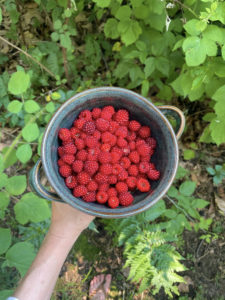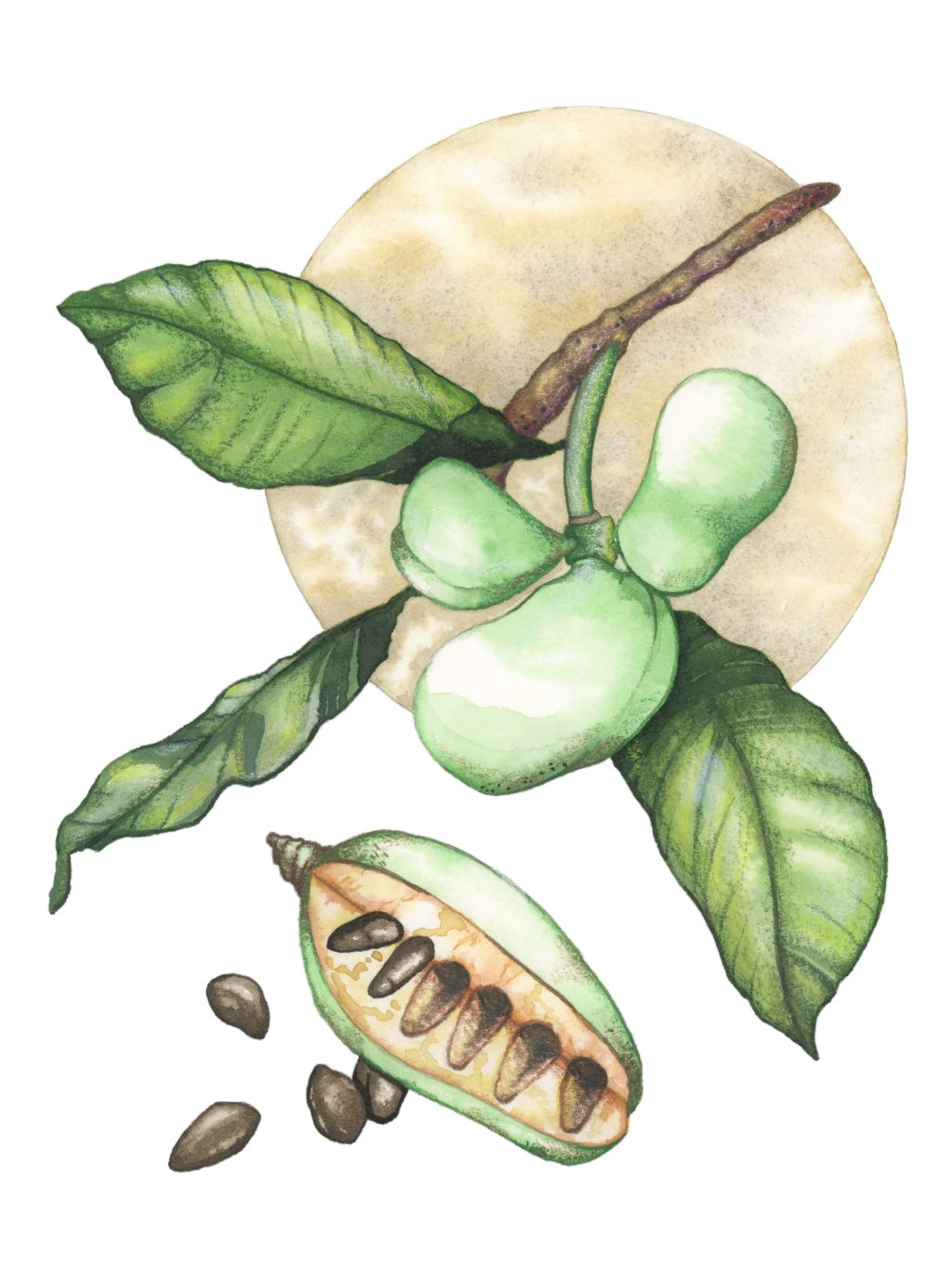Chesapeake Foraging for Beginners
On fine Sundays, when the church doors swing open and the faithful stream inside, my husband and I are lacing up our boots and hustling the dogs into the backseat of the car to attend services at our own “church.” We find fellowship and peace in the great hardwood cathedrals of the Eastern Shore on these Sunday walks. For us, god’s in the marshes and the eagles whistling above the canopy.
These rambles in all seasons turn up treasures, too. Seaglass and sometimes arrowheads, but mostly ripe pickings of the hedgerows and understory to stash in a pocket for later. Foraging seems too fancy a word for these opportunistic harvests. Tender fiddleheads, sour wineberries, hard green pawpaws find their way into our packs and our mouths. They get prepared in dishes at home or just enjoyed as is, no need to overshadow their bright flavors with too much fuss. Maybe these morsels are our version of communion. But maybe they are just how we casually observe and celebrate the abundance of the Chesapeake—a small, perfect blessing anyone who heads out into the Bay’s fields and woods is welcome to discover there.
SPRING FIDDLEHEADS
Late April is the best time to gather fiddleheads. Fresh, green, and firm, they explode with the flavors of new growth and spring rain. They are an easy foraging starter for the curious but slightly lazy—lots of fiddleheads can be found just past ditches along wooded roads or farm lanes where the greenbriar gives up to the shade of the deeper forest.

The key is to know what kind to look for. Not all ferns are edible, so keep your eye out for ostrich ferns in particular. The tightly-curled fiddleheads of the ostrich fern are about an inch across. The stems have a distinctive brown, papery scale on the outside and a deep groove running up the inside. Once you’ve spotted a patch, dive in with scissors or shears to snip an inch or so below the tight coil (not too much, since you want the fern to keep growing). Harvest as many as you like—the season for fiddleheads is short and once you’ve tried them, you’ll be missing them for the rest of the year.
At home, rinse your fiddleheads, keep them cool, and treat them like asparagus. I like to lightly saute my bounty in white wine, olive oil, and garlic before marrying them to fettuccine with a little pasta water and a healthy handful of fresh parmesan. Salt, pepper, a glass of crisp white to wash it all down with, and truly you have a feast.
SUMMER WINEBERRIES
The hottest cicada days of July are wineberry season. The feeling I have for these invasive delectables is—if you can’t beat ’em, eat ’em. Unlike blackberries, which ripen slightly later and prefer sunny banks and edges, wineberries are happiest with a little shade and wet feet, precisely the conditions you’re likely to crave when the dogs days are upon us.

Wineberries were introduced from east Asia in 1890, in a hubristic attempt to provide breeding stock for native raspberry cultivars gone awry. This fact gives me great pleasure in picking them, as I tell myself I am playing a critical role in managing the population. They are distinctive for their long canes and red, hairy stems that form thickets up to chest height. The fruits look like raspberries but substitute their signature jammy richness for a lighter, tarter flavor. When ripe, wineberries take on a deep ruby red color and can be easily plucked from the receptacle in their core.
Wineberry season is also black fly season, poison ivy season, and chigger season. Which means it is also long-pants-tucked-into-socks-and-Backwoods-OFF-season. No matter. Swatting and itching are small prices to pay in my quest for an overflowing bucket of the good stuff. Berry picking is meditative and once I hit pay dirt I have a hard time walking away. Two berries, three in my grasp, pluck to leave the soft green cores behind, dropped into my bucket soft and heavy with juice. And again.
Once my booty is home I almost never eat wineberries straight. They are too tart. I normally like them blended with vanilla greek yogurt and frozen for popsicles. But maybe the best way to enjoy them is to pair them with pastry. My friend Lydia came over one night and used all of my wineberries to make a galette. She just piled the wineberries into some pre-made pie crust, liberally sprinkled sugar over them and added a little cornstarch, and then folded the crust back over a bit into a free-form tart shape. Baked in the oven on 375 degrees for 20 minutes or so on a sheet of parchment paper, the wineberries dissolved into the most decadent, lush jam that ran over the edges and pooled around the crust. We could hardly keep our hands off it long enough to cool. Sliced into wedges and eaten on the front porch while we watched fireflies, it tasted like life and summer and the Eastern Shore, all at once.
FALL PAWPAWS
Pawpaws are a primordial fruit. Grown on trees in the understory of deep forest canopies, they were adapted to be consumed and spread by the megafauna of the last ice age. Three to six inches long with several large brown seeds inside, pawpaws are the largest fruit native to North America. It isn’t hard to imagine the giant sloths or mammoths that might have first plucked these tropical-tasting delicacies. The flavor (mango taste, avocado consistency) is surprising, because these “custard apples” don’t look like much. Greenish-blackish on the outside, a perfect camouflage with the shadiest part of the woods, pawpaws are easy to overlook.

The best solution is to scout a patch of pawpaws early in the season (maybe July, once their foliage is in full leaf) and return to check for fruit in late September. Pawpaws are thin, small trees that only grow to a maximum height of about 15 feet. For their size, their leaves are distinctively large—some of the biggest tree leaves in North America. Look for large, oblong-shaped, 12-inch leaves with smooth edges in clusters. Pawpaws grow in patches, so where you find one, you’ll usually find more.
Once you’ve picked your pawpaw patch and found your fruit, it’s time to harvest. Pawpaws have a very short (blink-and-you-missed-it) period of ripeness, so skip the fruit that has already fallen to the ground. Instead, pick a fruit directly from the tree. Pawpaws close to ripeness will be firm with a slight give. Leave the truly hard ones behind for the birds. Pawpaws bruise easily but never fear—black spots are fine. Eat them anyway.
There is really no way to gracefully eat a pawpaw, so expect to embrace your inner Neanderthal and just dig in. I like to slice mine open with a knife and use a spoon to scrape around the big seeds inside. Pawpaws are perfect without any additions or cooking needed, so enjoy the soft, bright yellow flesh unadulterated, the way your friendly megafauna might have. As you eat your foraged pawpaw, think of that ancient Chesapeake when cypress swamps and uplands were the domain and sustenance of the Earth’s last, great monsters.




